originally posted at https://canmom.tumblr.com/post/628879...
It’s Thursday, and it’s a pretty exciting Thursday: it’s time for Eva. Tonight we’re going to watch the three Rebuild of Evangelion movies.

If you’re even slightly into anime, you’ve very likely heard of Neon Genesis Evangelion - or at least seen the memes. The original 26-episode series and End of Evangelion would be too much for Animation Night, but luckily(?) for us, Hideaki Anno has spent more than a decade retelling the story as a series of theatrical films. Sort of.
So how do you introduce something as far-reaching as Eva? Perhaps we should rewind the clock and look at mecha anime as it was in the early 90s. I loathe ‘deconstruction’ readings, but Eva definitely needs to be seen in context to understand its impact.
Let’s meet Studio Gainax, founded in the 80s by a group of university students who were into mecha, sci-fi, and suchlike nerd things. The 80s were a good time to be into giant robots, with thriving scenes in both the classic ‘super robot’ genre (think unique, superpowered robots, shouted attacks etc.) and the alternative ‘real robot’ genre (typically geopolitical war stories in which mecha are interchangeable military hardware, with a lot of attention paid to realistic machine motion) exemplified by long-running series like Mobile Suit Gundam, Super Dimension Fortress Macross, Patlabor and even Armored Trooper VOTOMS.

But for all their heavy geopolitical themes, these shows were also the source of a new, massive trend: ‘gunpla’, plastic models of the robots. They had a hefty fan culture with conventions such as Daicon. This new generation of otaku could be accused of being more into machines than the politics - as the article I’m about to link puts it
Intensely apolitical and untouched by the war and occupation, they thought of military machines not as tools of terror, but things of beauty
Studio Gainax were anime fans who became anime producers - not the first to do this, but one of the most successful. Their earliest work was a con video that was just a bunch of references to other work, but they became much more established with their lavish, high-budget film Royal Space Force: The Wings of Honnêamise (funded generously by Bandai who wanted a slice of that otaku gunpla market).
So they were more than a little otaku-oriented throughout this period. That didn’t mean they weren’t often extremely good on an animation level. One of their star animators was Hideaki Anno, and you can see his work as an animator in the video above (not just with Gainax) - almost all exceptionally animated machines and explosions, all done before the age of computers making this kind of perspective drawing easy. (And yes, he did indeed animate those incredible God Warrior scenes in Nausicaa!)

Their best-known show from this period is probably Gunbuster, a blend of sports anime tropes with relativistic time-dilation sci-fi in the vein of The Forever War. It’s worth checking out, though be prepared for some of the horniness they’re also known for.
However, Gainax were not, at the time, a particularly successful studio. Royal Space Force was a flop, so they were mostly getting by on commission work and their much more successful porn games. In 1995, they committed to a project that would really change things up for them: Neon Genesis Evangelion.
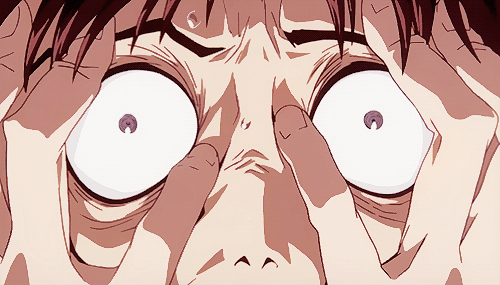
Eva was Hideaki Anno moving from animator to director position, and making a mecha show that stood out dramaticallly from mecha shows before it, both aesthetically and thematically. It’s a story about a semi-post-apocalyptic future, in which a traumatised boy is made by his abusive father to pilot terrifying biological robots for the sake of a mysterious, sinister conspiracy.
Exactly what NGE did that’s so distinct from prior mecha shows such as Gundam is a somewhat controversial topic. It’s not the first show where the main character finds fighting traumatising, nor the first show where he’s reluctant to ‘get in the robot’ (as the meme goes).
Rather, I think Eva’s main trick is that, rather than seeing mecha as a source of heroics or a more characterful spin on military hardware, they exist almost purely for their metaphorical potential. It’s not really a show about robots: it’s a show about personal trauma and depression, which happens to use robots as its central metaphor.
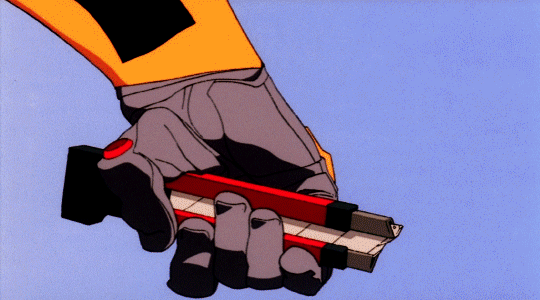
The robots in Eva are not really robots, but repurposed monsters only barely under human control. They sprint, roar, and especially suffer injuries in a very animal way. And meanwhile, the show’s aesthetic makes heavy use of both biology (‘central dogma’) and esoteric Christian symbolism (from the obvious like monsters called ‘Angels’ and cross-shaped explosions to the slightly more obscure allusions like the Magi computers, not to mention the whole Adam/Lilith metaplot). Its allusions are often criticised as meaningless appropriation of a distant culture just because it looked cool, but like all Eva’s aesthetic choices, it creates a distinctive and alienating effect.
At first, the show seems to take an almost ‘monster of the week’ framing - though the ‘Angels’ that Shinji fought would range from unusually proportioned humanoids to very abstract stuff like an orbiting cloud of blobs, or an octahedron. Soon other, equally traumatised pilots were introduced alongside Shinji, from the seemingly emotionless Rei to the brittly proud Asuka.
We watch NERV hold on against the Angels, just about, and now and then we’d see Gendo up to something, or things would go terribly wrong with the Evas. We get to know the various adult members of the organisation like Misato, Ritsuko and Asaji, who have their own tangle of relationships and repressed emotional problems.
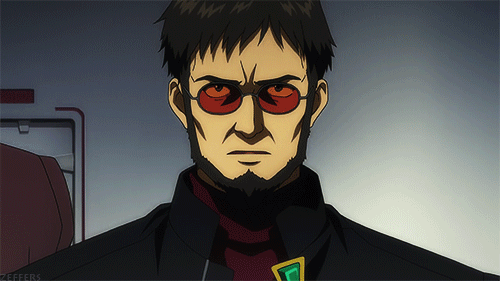
And as the show went on, things got weird. The conspiracy elements hinted at in earlier episodes became more significant, The angels got increasingly personally invasive and unsettling, the robots less effective against them. Shinji is psychologically tortured by the power of the organisations around him, the uncaring and equally broken adults, his miserable experiences in battle, and what happens to his few friends. The secondary characters discover some of the weird shit at NERV, we learn more about the awful background (like what became of Shinji’s mother) and become aware of the impending apocalyptic eschaton of ‘Third Impact’. Near the end, Shinji briefly gets a boyfriend, but he turns out to be an Angel, who he has to murder.

Eva works so well in large part due to its absolute brilliance with imagery and composition. So many of its characters and shots have become iconic, referenced (much like the bike in Akira) across other animated works, whether it’s Gendo doing the glasses thing or the ‘congratulations’ scene at the end. The Evas are not stiff and clunky, but lithe and agile in a way robots had (almost?) never been before. It would not be long before it would inspire a wave of imitators, like Studio Bones’s RahXephon.
However, despite (or perhaps even because of) the immense success of his show, Hideaki Anno got extremely depressed and ever more disgusted with the otaku culture that had produced him. And awkwardly, for the last two episodes of the show, Gainax’s budget was far too tight to follow their original plan. So Anno went deeply experimental: the last two episodes of Eva take place almost entirely in Shinji’s head, facing him directly with his trauma and unwillingness to connect with other people (on which, through a twist of events, the shape of Third Impact ultimately hinges). For a show about giant robot fights, it was a very bold choice.
It was not exactly well-received. But controversy can also be a source of attention!
At this point, Eva was one of the biggest anime - all the more so when it got its Western release and rapidly outshone the mecha shows that inspired it in terms of sales. Gainax suddenly had all the money in the world. They made a followup movie to end Eva (which had its own troubled production), and it was absolutely harrowing - almost a ‘fuck you’ to the otaku fans who, Anno seemed to feel, had totally missed the point of his show. Beloved characters like Asuka are horrifically injured, Shinji gives in to his worst creepy impulses, and the developing apocalypse melts everyone into a sea of red fluid. The last shot has Shinji crying in a bizarre landscape of broken Reis, while Asuka condemns him as ‘disgusting’.
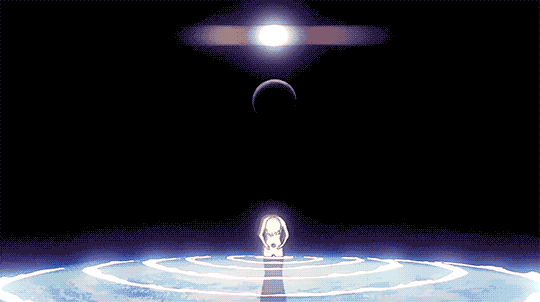
Despite some rather dubious aspects of its production (such as the treatment of Asuka’s voice actress), it’s an incredible movie, with some of the most striking images in anime. At the same time it’s definitely not one I’d watch lightly. But the sheer gut-punch nature of it made it a kind of cult classic in its own right.
In the aftermath, Gainax would go on to make a kind of antidote show in Tengen Toppa Gurren Lagann, a super robot about hot-blooded boys believing in each other hard enough to toss galaxies around. Soon after, Gainax would effectively end as a studio, though many of their animators would go on to found the renowned Studio Trigger.
Anno, meanwhile, was not finished with Eva. In the mid-2000s, he went off to launch a new studio: Khara. We’ve seen some of their work before: right back at the beginning of Animation Night, they were the ones who organised the Animator Expo.
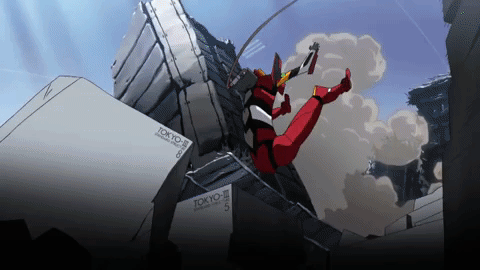
Their main project was the Rebuild of Evangelion series: a kind of retelling of the story of Evangelion in movie form, supported by the ludicrously profitable Eva franchise with its merch, figurines etc. It’s not a straight retelling, though: many scenes are changed, new characters are added; it’s not simply ‘Eva but with better visuals’ (though the visuals are incredible) but a kind of reinterpretation and elaboration of the themes of the series.
Like most things Eva, it’s rather controversial! I think many fans of the original series see it as fucking around with something that wasn’t broken in the first place, just out of self-indulgence. But that may well be deliberate - undermining the attempt to sanctify Eva, a rejoinder against getting lost in the minutiae of its convoluted lore and missing the (now slightly further developed) thematic payload.
I’m not sure what my take is, because I haven’t seen these movies! But my wonderful girlfriend @velocityvsreality rates them highly, so I am extremely stoked to see them tonight.
Because three movies is quite a bit, we’ll be starting pretty promptly at 7pm UK time (allowing maybe 10 minutes for people to come in), which is about 4 hours from this post. The place will be twitch.tv/canmom. Hope to see you there and enjoy what’s going to be, at the very least, an absolute spectacle of animation.
Comments